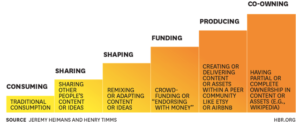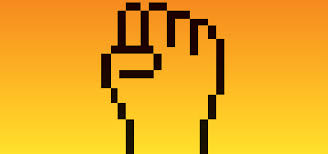Technopreneurs need to understand and embrace “new power”
As technopreneurs, we often see opportunities and threats in our hyperconnected world, but we need to go beyond this to understand a powerful new underlying force at work, “new power”, which is a about mobilisation, and channeling participatory energy. Its effect is visible in successful companies (Facebook, Airbnb, YouTube, Etsy), in politics and wars (Trump’s election campaign, ISIS) and society (#MeToo).
In a Harvard Business Review article and new book, Timms and Heimans explain “new power”, asserting that “by understanding new power you can reshape the world around you”. A complex transformation is just beginning, one driven by a growing tension between two distinct forces: old power and new power.
Old power works like a currency. It is held by few. Once gained, it is jealously guarded, and the powerful have a substantial store of it to spend. It is closed, inaccessible, and leader-driven. It downloads, and it captures.
New power operates differently, like a current. It is made by many. It is open, participatory, and peer-driven. It uploads, and it distributes. Like water or electricity, it’s most forceful when it surges. The goal with new power is not to hoard it but to channel it.
Old power models tend to require little more than consumption. A magazine asks readers to renew their subscriptions, a manufacturer asks customers to buy its shoes. But new power taps into people’s growing capacity—and desire—to participate in ways that go beyond consumption. These behaviors, laid out in the exhibit “The Participation Scale,” include sharing (taking other people’s content and sharing it with audiences), shaping (remixing or adapting existing content or assets with a new message or flavor), funding (endorsing with money), producing (creating content or delivering products and services within a peer community such as YouTube, Etsy, or Airbnb), and co-owning (as seen in models like Wikipedia and open source software).

New Power Values
As new power models become integrated into the daily lives of people and the operating systems of communities and societies, a new set of values and beliefs is being forged. Power is not just flowing differently; people are feeling and thinking differently about it. A teenager with her own YouTube channel engages as a content creator rather than as a passive recipient of someone else’s ideas. A borrower on the peer-to-peer finance platform Lending Club can disintermediate that oldest of old power institutions, the bank. A Lyft user experiences consumption as a kind of sharing and subtly shifts his view of asset ownership.
These feedback loops—or maybe we should call them “feed-in” loops, given that they’re based on participation—make visible the payoffs of peer-based collective action and endow people with a sense of power. In doing so, they strengthen norms around collaboration and make the case that we can do just fine without the old power middlemen that dominated the 20th century. Public polls reflect the shifting attitudes toward established institutions. For example, the 2014 Edelman Trust Barometer shows the largest deficit in trust in business and government since the survey began in 2001.
Among those heavily engaged with new power—particularly people under 30 (more than half the world’s population)—a common assumption is emerging: We all have an inalienable right to participate. For earlier generations, participation might have meant only the right to vote in elections every few years or maybe to join a union or religious community. Today, people increasingly expect to actively shape or create many aspects of their lives. These expectations are giving rise to a new set of values in a number of realms:
– Governance
New power favors informal, networked approaches to governance and decision making. The new power crowd would not have invented the United Nations, for instance; rather, it gravitates toward the view that big social problems can be solved without state action or bureaucracy. Often encountered in Silicon Valley, this ethos has at its core a deep and sometimes naive faith in the power of innovation and networks to provide public goods traditionally supplied by government or big institutions. Formal representation is deprioritized; new power is more flash mob and less General Assembly.
– Collaboration
New power norms place a special emphasis on collaboration, and not just as a way to get things done or as part of a mandated “consultation process.” New power models, at their best, reinforce the human instinct to cooperate (rather than compete) by rewarding those who share their own ideas, spread those of others, or build on existing ideas to make them better. Sharing-economy models, for example, are driven by the accumulated verdict of the community. They rely on reputation systems that ensure that, say, rude or messy guests on Airbnb have trouble finding their next places to stay.
– DIO
New power is also engendering a “do it ourselves” ethic, as Scott Heiferman, the CEO of Meetup, puts it, and a belief in amateur culture in arenas that used to be characterized by specialization and professionalization. The heroes in new power are “makers” who produce their own content, grow their own food, or build their own gadgets.
– Transparency
New power proponents believe that the more light we shine, the better. Traditional notions of privacy are being replaced by a kind of permanent transparency as young people live their lives on social media.
– Affiliation
New power loves to affiliate, but affiliation in this new world is much less enduring. People are less likely to be card-carrying members of organizations (just ask groups like the ACLU that are seeing this form of membership threatened) or to forge decades-long relationships with institutions. So while people with a new power mindset are quick to join or share (and thanks to new power models, “joining” is easier than ever), they are reluctant to swear allegiance. This makes new power models vulnerable. New power is fast—but it is also fickle.
New power is also fundamentally changing the way everyday people see themselves in relation to institutions, authority, and one another. These new norms aren’t necessarily better. For instance, new power offers real opportunities to enfranchise and empower, but there’s a fine line between democratizing participation and a mob mentality. This is especially the case for self-organized networks that lack formal protections. New power can easily veer in the direction of a Tea Party or an Occupy Wall Street. (We assume that most people think at least one of these is a bad thing.)
Cultivating New Power
Most organizations recognize that the nature of power is changing. But relatively few understand the keys to influence and impact in this new era. Companies see newly powerful entities using social media, so they layer on a bit of technology without changing their underlying models or values. They hire chief innovation officers who serve as “digital beards” for old power leaders. They “reach out” via Twitter.
Traditional organizations that want to develop new power capacity must engage in three essential tasks: (1) assess their place in a shifting power environment, (2) channel their harshest critic, and (3) develop a mobilization capacity.
Old power organizations need to do more than just look inward; they also need to think differently about how they reach out. Organizations that have built their business models on consumption or other minimal participation behaviors will find this challenging but increasingly important.
The capacity to mobilize a much wider community of people can be a critical business advantage, as we saw in the defeat of “online piracy” legislation in the United States, in 2012. In that conflict between technology companies and copyright holders, both sides enlisted armies of lobbyists, but only one side was able to mobilize an army of citizens. Google, Wikipedia, and other organizations inspired meaningful action—10 million petition signatories, more than 100,000 calls to Congress, and a “blackout” of the internet—creating a cultural surge when it mattered.
To succeed, a movement needs much more than ad campaigns or “astroturfing.” Leaders must be able to actually mobilize true believers, not just talk at them. A key new power question for all organizations is “Who will really show up for you?”
Credit: Harvard Business Review Understanding “New Power” by Henry Timms & Jeremy Heimans
